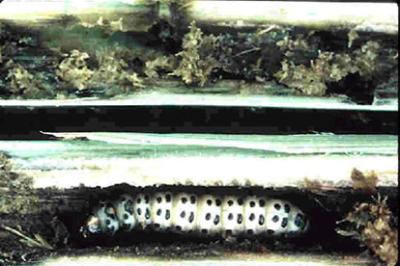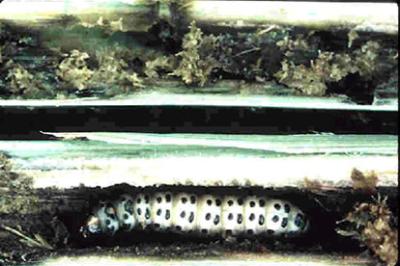

Stemborers
Several species of stemborers attack millet including the millet stemborer (Coniesta ignefusalis), the maize stalkborer (Busseola fusca), the spotted stalkborer (Chilo partellus), and the pink stalkborer (Sesamia calamitis).
Stemborer caterpillars bore into stems of millets disrupting the flow of nutrient from the roots to the upper parts of plants. Attack on young millet plants causes damage known as "dead hearts". In older plants the top part of the stem dies as a result of tunnelling by the borers.
The millet stemborer (Coniesta ignefusalis)
It is the dominant stemborer of millet in the Sahelian zone of Africa, and also attacks sorghum, maize, and wild grasses. Major damage has been reported in West Africa. It has also been found causing considerable damage to millet in Western Eritrea, being considered as the major pest of millets in Eritrea (B. Le Ru, icipe, personal communication). The moths have golden brown forewings. They are active throughout the night and during the day rest on the lower surface of leaves or along stems. Caterpillars are cream-coloured with black spots along the body. However in the dry season, when caterpillars enter in diapause (a resting period) they change colour to pale yellow or uniform cream white. They stay in this resting period from 6 to 7 months, but occasionally for more than a year.
Moths lay eggs between the leaf sheet and the stem in batches of 20 to 50 eggs. Caterpillars tunnel in the leaf sheets and in the underlying stem. They normally pupate within the stem. Small plants on which eggs are laid may be thoroughly riddle with caterpillars and soon collapse, but in larger plants external symptoms show two to three weeks after stems have been infested.
Economic damage results from early plant death ( "dead-heart") stem tunnelling, disruption of nutrient flow, steam breakage, poor or no grain formation and empty heads. Crop losses have been estimated at $91 million a year.
For more information on the African maize stalk borer click here. For more information on the Spotted stalkborer click here.
- Sow early, soon after first rains. Delayed planting tends to increase the incidence of diapause, resulting in significantly higher numbers of diapausing larvae in millet stalks at the end of the growing season. Burn all crop residue left in the field after harvest. When using millet stalks for construction, burn them partially immediately after harvest.
- Use resistant varieties if available
- Monitor the millet stemborer. In West Africa, pheromone technology has proved to be highly effective in monitoring this stem borer. These pheromones can also be used to reduce stemborer populations.
Mass trapping using pheromones has been tried in farmers' fields in Niger. These traps were particularly effective along fences and granaries, areas that harbour borers. Results indicate that inexpensive, locally made pheromone-baited traps are efficient and well adapted to local conditions (ICRISAT).
